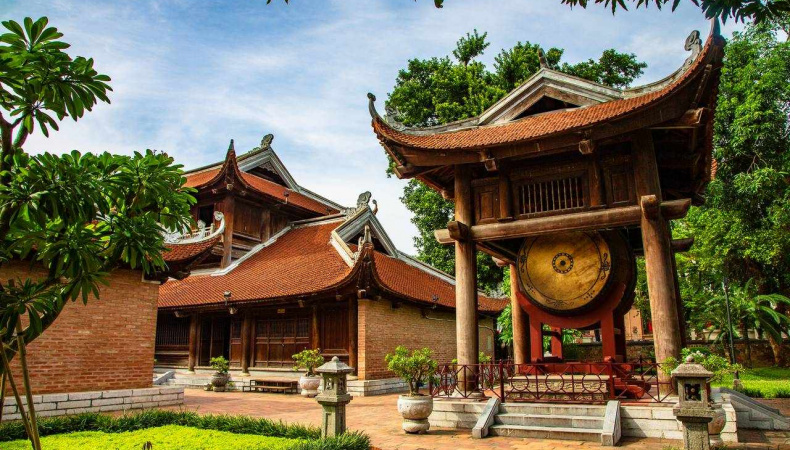Top experience you may interested in:
When planning your trip to Hanoi, don’t forget to visit Temple of literature, an incredibly captivating landmark in the capital city of Hanoi! This complex of historical relics is located in the southern part of the former Thang Long Imperial Citadel. Temple of literature is also known as the first university in Vietnam.
Introduction to Temple of literature:
- Address: 58 Quoc Tu Giam Street, Van Mieu Ward, Dong Da District, Hanoi, Vietnam
- Opening hours: 7:30 AM – 5:30 PM (summer); 8:00 AM – 5:00 PM (winter) daily
- Admission fee for Temple of literature in Hanoi: 30,000 VND per person
Temple of literature is located in Dong Da District, right in the heart of four bustling streets: Nguyen Thai Hoc, Van Mieu, Quoc Tu Giam, and Ton Duc Thang. Please note that there are many one-way streets around Van Mieu.
Temple of literature is the first National University of Vietnam and has trained numerous generations of talents for the country. The temple honors three outstanding kings of the nation: Ly Thanh Tong, Ly Nhan Tong, and Le Thanh Tong.

The historical site reflects the spirit of reverence for learning, admiration for talented individuals, and the tradition of filial piety in our nation. Temple of literature is a famous Confucian historical relic, showcasing remarkable art, aesthetics, and architecture.
When you visit this place, you will have the opportunity to admire various valuable documents and artifacts. Especially noteworthy are the 82 stone stelae of doctoral candidates, recognized by UNESCO as the “World Documentary Heritage.”
Currently, Temple of literature has become a fascinating cultural tourist destination and was classified as a National Monument in 1962.
History and Architecture of Temple of literature:
- In 1070, Van Mieu was constructed during the reign of King Ly Thanh Tong. Initially, it was a place to worship Confucius, his four disciples, and Yan Hui.
- In 1076, King Ly Nhan Tong built Quoc Tu Giam right next to Van Mieu, serving as the place for educating the king’s children and aristocratic families.
- Under King Tran Thai Tong’s reign, the place was renamed as Quoc Hoc Vien, providing education for exceptionally talented commoners.
- During the reign of King Le Thanh Tong, the stone stelae of doctoral candidates began to be erected at Temple of literature.
- During the Nguyen Dynasty, Quoc Tu Giam was also established in Hue. Van Mieu was renovated and later renamed as Van Mieu Hanoi.
In 1947, during the French colonial period, the temple was heavily damaged, leaving only the foundation and four stone stelae columns.
Architecture:
This historical site covers an area of approximately 54,331 square meters and includes various structures such as Ho Van, Van Mieu, Quoc Tu Giam, Vườn Giám, Khuê Văn Các, and more. The surroundings are adorned with weathered colorful bricks.
The architecture of Temple of literature reflects the early Nguyen Dynasty’s imperial architectural style. Each section is symmetrically arranged along the North-South axis, following traditional practices.

Places to Visit in Temple of literature:
Temple of literature is part of Vietnam’s special National Heritage system, with its rich historical and cultural significance and many interesting places to explore:
Van Mieu Gate:
Van Mieu Gate is the outer three-entrance gate of the historical site. It consists of three doors and two floors. The upper floor has the words “Van Mieu Gate” written in ancient Chinese characters.
In front of the Van Mieu Gate, there are two stone stelae on both sides of the main entrance. The Van Mieu Gate exudes a sense of solemnity and reverence.
Ho Van and Vườn Giám:
Ho Van, also known as Ho Giám or Ho Minh Duong, is a lake located right in front of the entrance to Van Mieu.
Ho Van is quite spacious, with Kim Chau Mound in the middle. On top of the mound is the Phan Thuy Duong, where ancient scholars used to discuss literary and scholarly matters.
Vườn Giám is located on the western side of Van Mieu and features an octagonal house, a pond, various trees, and other small landscapes. This garden area serves as a place for visitors to relax and enjoy cultural activities.

Dai Trung Mon:
Dai Trung Mon is the second gate of Temple of literature. It consists of three bays built on high brick platforms, and the roofs are designed in the ancient architectural style with tiled roofs.
In front of and behind Dai Trung Mon, there are vast open spaces with parallel roads, green trees, and tranquil water, creating a peaceful atmosphere amid the bustling city.
Khuê Văn Các:
Khuê Văn Các was built in 1805 by General Nguyen Van Thanh during the Nguyen Dynasty. It is an eight-sided pavilion with a height of nearly 9 meters, including four lower roofs and four upper roofs.
Khuê Văn Các stands on a square foundation with each side being about 6.8 meters long. This structure impresses with its unique and extraordinary ancient architectural style.
The ground floor features four square brick columns adorned with delicate patterns. The upper floor is decorated with gilded lacquer, and two red-tiled roofs overlap each other. The round windows on the attic level add a prominent touch, resembling shining stars.
Doctoral Stelae Garden and Thiên Quang Well:
The Doctoral Stelae Garden is an unmissable place to visit in Temple of literature. The 82 doctoral stelae here are intricately carved masterpieces with profound spiritual significance.
These stelae are placed on the backs of stone tortoises, and they contain information about 82 top-ranked scholars from various dynasties in Vietnam. On March 9, 2010, these 82 stone stelae were recognized by UNESCO as World Documentary Heritage.
Thiên Quang Well, located next to the Doctoral Stelae Garden and right behind Khuê Văn Các, is a square-shaped well symbolizing the earth. It is also known as Ao Van. The well was designed to collect the essence of the universe and illuminate knowledge.
Khải Thánh Temple:
Located at the far end of the historical site is Khải Thánh Temple, which worships the parents of Confucius – K’ung Shang-jen and Nhan Thi. In the past, Khải Thánh Temple was a residential area with 150 rooms for students.
In 1946, during the French colonial period, Khải Thánh Temple was heavily damaged, and the entire structure was destroyed. It was later rebuilt and preserved to this day.
Đại Bái Đường – Đại Thành Môn:
Đại Thành Môn is a three-bay structure with tiled roofs and two solid pillars at the front and back. Beyond Đại Thành Môn is Đại Bái Đường, the ancestral shrine.
Inside Đại Bái Đường, there are numerous valuable horizontal lacquered boards, incense offerings, and a pair of ancient carved cranes along with a large bell cast in the Canh Hung year of 1768. Đại Bái Đường consists of nine bays and was once the place for various ceremonies during ancient festivals.
Fascinating Experiences Not to Miss:
- Temple of literature preserves a rich traditional culture and fascinating history, making it a super attractive destination with a wide range of exciting activities:
- Participate in the poetry club organized on the full moon of the first lunar month.
- Request a calligraphy art at Temple of literature.
- Light incense to pray for success in academic exams.
- Explore and learn about the architecture, history, and displayed artifacts at Van Mieu.
- Take photos at the ancient and picturesque spots.
- Temple of literature is also a place to praise outstanding students. During Tet (Lunar New Year), various traditional and folk activities are held here to preserve the cultural heritage.
Tips for Visiting Temple of literature:
- When visiting this historical site, please:
- Observe the regulations set by the management, respect the relics, and avoid damaging artifacts or landscapes.
- Do not touch the heads of the stone tortoises and do not sit on the doctoral stelae.
- Dress appropriately and neatly.
- Maintain order and avoid using profanity.
- Light only one incense stick per person.
Top attraction to visit in Ha Noi



